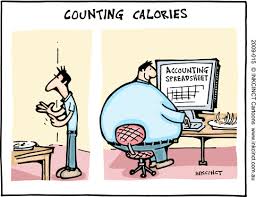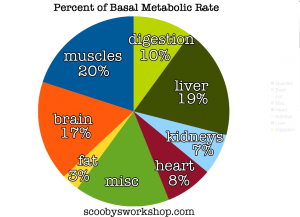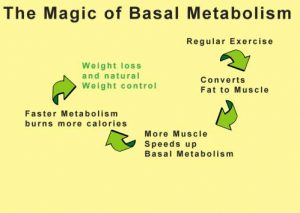The first thing we will need to do is calculate basal metabolic rate (BMR). BMR is defined as the rate at which the body uses energy while at rest to keep the vital functions going (definition from Google).
Oh, O.K. What does that actually mean?
Simply , BMR is the number of calories your body needs to survive while laying in bed all day (sleeping, actually). Our bodies constantly burn calories. Our heart pumps, calories are burned. We breathe, calories are burned. We dream, calories are burned. We require a minimum amount of nourishment (food) in order to keep our bodily functions running normally. If we do not get the necessary calories, bad things happen including fatigue, inability to think clearly and, in the worst cases, depression and irritability. The reality is that most fad diets that promise a lot of weight loss in a short period of time require calorie intake well below an individual’s BMR. This is why most people are miserable and usually fail to continue and then gain all the weight back.
What’s more, your body has an internal security system. When it senses that it is not getting enough nourishment, it slows the metabolism and keeps whatever reserves it has (usually in fat). So weight loss become harder.
Remember this because when we talk about diet, I believe you will be shocked as to how much you are going to eat but are still able to lose weight.
There are three processes when calculating BMR for weight loss. First, we must calculate BMR when the body is completely at rest. Next, we calculate the BMR with a variable that defines daily activity level. Finally, we subtract the number of calories that will lead to the loss of one pound per week. The formula I use is the Harris-Benedict equation. There is a modified equation called the Roza and Shizgal equation and it works also. I am just used to the Harris-Benedict and I know it works. There are hundreds of BMR calculators on the Internet but I like doing the math.
Here is the formula to calculate base BMR:
Men: BMR = 66 + ( 6.2 × weight in pounds ) + ( 12.7 × height in inches ) – ( 6.76 × age in years )
Women: BMR = 655.1 + ( 4.35 × weight in pounds ) + ( 4.7 × height in inches ) – ( 4.7 × age in years )
Now, let’s do the math using me when I was heavy as an example. I am 5’7″, weighed 210 pounds and was 40 years old. I’m also a male (I shouldn’t assume you know that).
BMR = 66 + (6.2 x 210) + (12.7 x 67) – (6.76 x 40)
BMR = 66+ 1302 + 851 – 270
BMR = 1949
So I needed 1949 calories per day to maintain my weight and keep all my function running smoothly. Of course, this only applies if a plan to stay in bed all day. Now we have to calculate activity. The following chart lists activity levels and the variable you will use to apply to the BMR. Now, be honest. If the only exercise you get during the day is lifting a Twinkie to your mouth, you have an activity level of one not four.
- Little to no exercise (You have a job) – BMR x 1.2
- Light exercise (exercise 1-3 days a week) – BMR x 1.375
- Moderate exercise (exercise 3-5 times a week) – BMR x 1.55
- Heavy exercise (exercise 6-7 days a week) – BMR x 1.725
- Very heavy exercise (you’re in prison) – BMR x 1.9
I am not proud to say this, but I marked myself as light exercise. At the time, I would run and do push ups a few times a week.
BMRmod1=1949 x 1.375 = 2679.875 = 2680
Now, it is time for the magic. I want to lose one pound per week. That is a safe way the lose weight permanently. One pound is made up of 3500 calories. If I cut 500 calories per day, I will lose one pound per week.
BMRmod2 = 2680 – 500 = 2180
That’s it! In order for me to lose a pound a week, I need to take in 2180 calories a week. That sounds like a lot, and it might be, compared to what you are used to. But it is important to take in those calories the right way.
The next part, we will go through the proper diet. Like I said, be prepared to eat.
Photos courtesy of:
www.free-online-calculator-use.com
fit4liferbm.wordpress.com
www.dietnet.gr
www.mcroberts.nl
www.fuelingforhealth.com
scoobysworkshop.com





